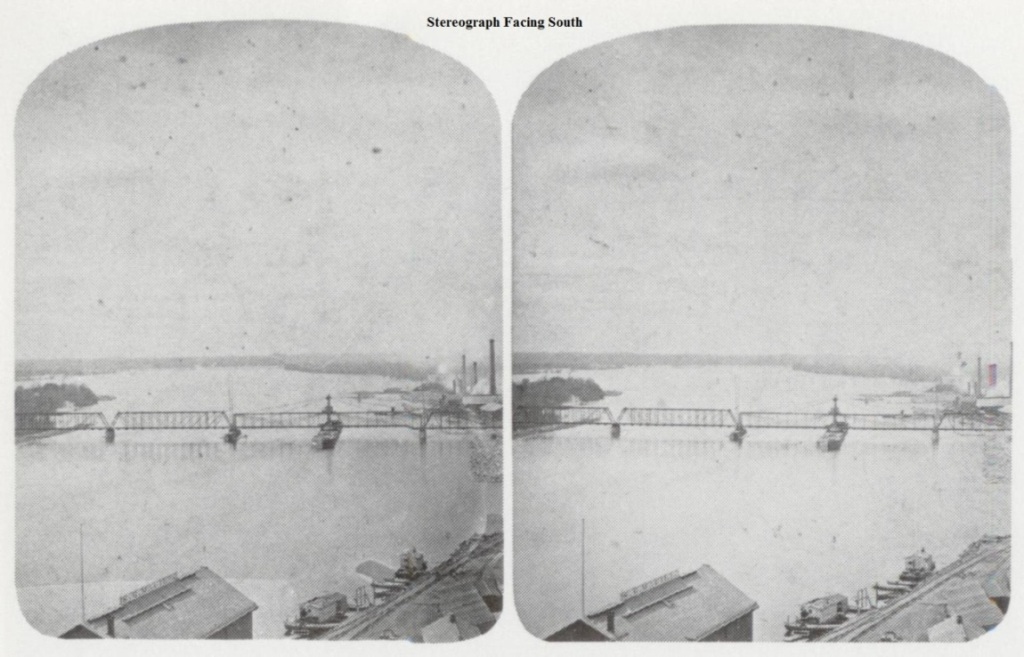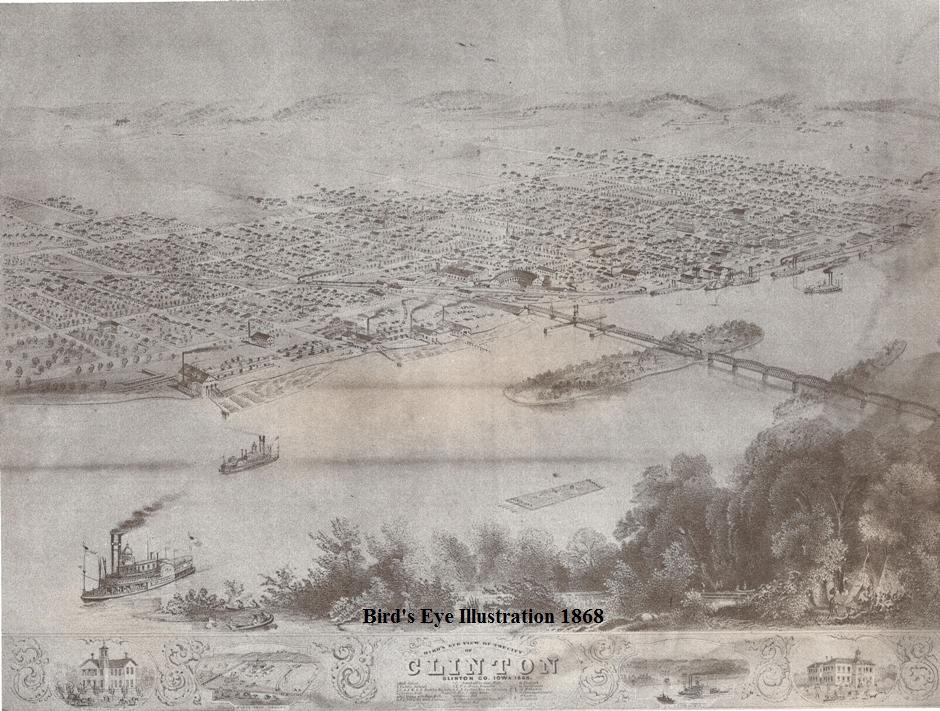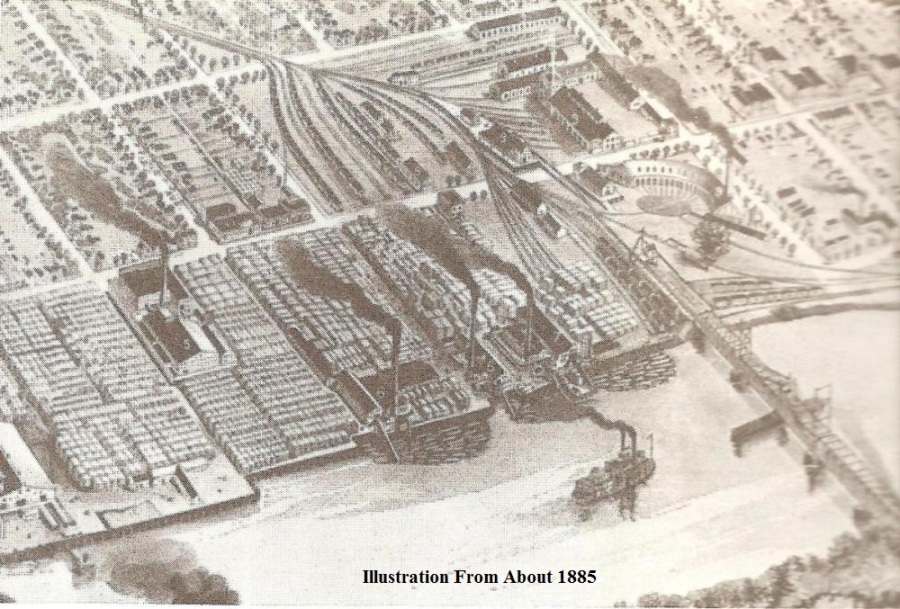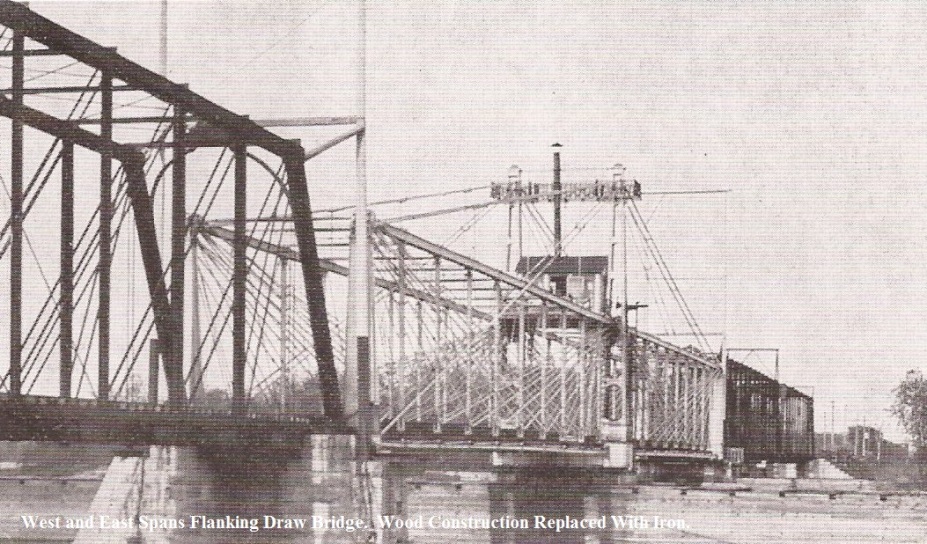Completion of Old Clinton Rail Bridge - 1865
From: The Clinton Herald, July 7, 1865, P.2
Transcribed by a Clinton County IaGenWeb volunteer.
 The traveling public have almost as much cause for rejoicing as the Railroad
Company, and neither will be more benefited and gratified at the completion of
the bridge across the Mississippi at this point than the people of the interior.
Yesterday morning, about 9 o’clock, the immense iron draw was successfully swing
around, and at 4 o’clock in the afternoon a locomotive made the transit, soon
followed by another with several cars attached. A train consisting of twenty
loaded freight cars next crossed, when the bridge was declared as formally
opened. The length of the new bridge is 850 feet, including the draw, which is
300 feet in length, constructed entirely of iron. The length of the old bridge,
from Little Rock Island to the Illinois shore, is 1400 feet, exclusive of a
trestle work 1500 feet long – making a total length of 3750 feet. We reserve for
a future issue a more minute description of the bridge, its cost, water marks,
etc., some of which facts it is impossible at present to ascertain.
The traveling public have almost as much cause for rejoicing as the Railroad
Company, and neither will be more benefited and gratified at the completion of
the bridge across the Mississippi at this point than the people of the interior.
Yesterday morning, about 9 o’clock, the immense iron draw was successfully swing
around, and at 4 o’clock in the afternoon a locomotive made the transit, soon
followed by another with several cars attached. A train consisting of twenty
loaded freight cars next crossed, when the bridge was declared as formally
opened. The length of the new bridge is 850 feet, including the draw, which is
300 feet in length, constructed entirely of iron. The length of the old bridge,
from Little Rock Island to the Illinois shore, is 1400 feet, exclusive of a
trestle work 1500 feet long – making a total length of 3750 feet. We reserve for
a future issue a more minute description of the bridge, its cost, water marks,
etc., some of which facts it is impossible at present to ascertain.
OLD BRIDGE ON ITS LAST LEGS.
The Clinton Daily Herald, February 23, 1909
WORK OF RAZING ANCIENT STEEL STRUCTURE COMMENCES THIS MORNING.
WILL SOON DISAPPEAR.
Destruction of Old Channel Spans Commences Ten Minutes after Official Order for
Trains’ Operation Over New Bridge Goes into Effect.
At nine o’clock this morning a crew of men commenced the work of tearing down
the old bridge of the Chicago & Northwestern railroad, between the island and
the Iowa shore. In three weeks the last vestige of the channel spans will have
disappeared, far below the waterline; and by the time the first steamboat
whistles for the bridge this spring, the splendid electrically driven draw of
the new bridge will be ready to respond.
At 8:50 o’clock this morning, ten minutes before the crew of men assailed the
tracks on the deck of the old bridge and started to tear them out, as the first
operation in the destruction of the bridge, trains commenced to run regularly
over the new bridge.

 The channel spans of the great structure are not yet complete, however. Only one
of the two tracks across the bridge is ready for use, and for the present this
will be used by both west and east bound trains. It will probably be three weeks
before both tracks are completed, and some 20,000 rivets which yet remain to be
driven, are all in their places. Thus some three weeks’ work remains to be done
on the big bridge before it is entirely completed.
The channel spans of the great structure are not yet complete, however. Only one
of the two tracks across the bridge is ready for use, and for the present this
will be used by both west and east bound trains. It will probably be three weeks
before both tracks are completed, and some 20,000 rivets which yet remain to be
driven, are all in their places. Thus some three weeks’ work remains to be done
on the big bridge before it is entirely completed.
EARLY HISTORY OF C. & N. W.
The Clinton Daily Herald, February 3, 1909
INTERESTING STATISTICS CONCERNING OPENING OF THE FIRST BRIDGE.
PIONEER TRAINS.
Engines, Cars, Conductors and Engineers Making First Crossing of Original Bridge
– The Extension to Boone.
An interesting memorandum of Chicago & Northwestern railway bridge and railroad
information has been kept by C. C. Fenlon, who was on the “extra list” of the
company when the first railroad bridge was completed across the Mississippi
river at Clinton, and from it the following statistics of interest in connection
with the opening of the new bridge in the near future, have been gleaned.
 The original bridge was completed from Little Rock island to the Iowa shore on
January 6, 1865. The first engine to cross the bridge was No. 1 with a Michigan
Central flat car, No. 2556, at 3:45 o’clock in the afternoon of that day.
Superintendent E. B. Talcott of the Galena division was at the throttle. Mr.
Talcott died some years ago.
The original bridge was completed from Little Rock island to the Iowa shore on
January 6, 1865. The first engine to cross the bridge was No. 1 with a Michigan
Central flat car, No. 2556, at 3:45 o’clock in the afternoon of that day.
Superintendent E. B. Talcott of the Galena division was at the throttle. Mr.
Talcott died some years ago.
 The first passenger train to cross the bridge was in charge of Conduction Joseph
Dennison, who is now in California. It made the journey from Illinois to the
Iowa shore at 4 o’clock p. m. on the day of the opening of the bridge. The first
freight train from Chicago to cross the bridge made the trip on January 12,
1865, and was in charge of Conductor Charles Mason, now dead. The first
east-bound freight to cross, on the same date, was in charge of Conductor Ed
Hamilton, also now dead.
The first passenger train to cross the bridge was in charge of Conduction Joseph
Dennison, who is now in California. It made the journey from Illinois to the
Iowa shore at 4 o’clock p. m. on the day of the opening of the bridge. The first
freight train from Chicago to cross the bridge made the trip on January 12,
1865, and was in charge of Conductor Charles Mason, now dead. The first
east-bound freight to cross, on the same date, was in charge of Conductor Ed
Hamilton, also now dead.
 At the time of the completion of the bridge the end of the road was at Nevada,
Iowa, but the extension to Boone was completed on Sunday, July 16, 1865, and on
Monday, July 17, 1865, Conductor Jim Lane, now deceased, was in charge of the
first east-bound train out of Boone, having made the trip from Nevada to Boone
the day before, Conductor Oliver Smith, now deceased, was in charge of the first
through train from Clinton to Boone, making the trip on July 17, 1865.
At the time of the completion of the bridge the end of the road was at Nevada,
Iowa, but the extension to Boone was completed on Sunday, July 16, 1865, and on
Monday, July 17, 1865, Conductor Jim Lane, now deceased, was in charge of the
first east-bound train out of Boone, having made the trip from Nevada to Boone
the day before, Conductor Oliver Smith, now deceased, was in charge of the first
through train from Clinton to Boone, making the trip on July 17, 1865.
 Conductor Moffatt was the first conductor to arrive at Boone on a freight train,
July 17, 1865, and Conductor Lon Thurston was the first conductor to leave Boone
on a freight, the same date.
Conductor Moffatt was the first conductor to arrive at Boone on a freight train,
July 17, 1865, and Conductor Lon Thurston was the first conductor to leave Boone
on a freight, the same date.
Before the completion of the bridge from Little Rock island to the Iowa shore,
trains were ferried across the river. For a number of years, after the opening
of the bridge, a wooden structure from the Illinois short to Little Rock island
was used.



